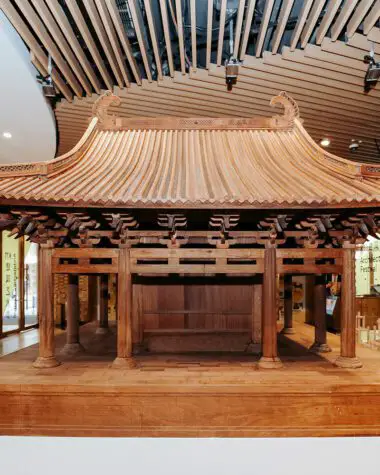Early Chinese had proven their innovative influences regarding woods because they are still relevant and evident today. For instance, most of the old western buildings and architectural systems erected with stones were inspired by old Chinese woodworking. It was the product of their excellence at using wood and creating a complex structure of the notch and spike joint to incorporate the unique aesthetics of ancient Chinese wood architecture.
Earliest Chinese Wooden Architecture
Because they were skilled woodworkers, the ancient Chinese developed the intricate mortise and tenon joint system, adding to their structural beauty. Wood was primarily used to construct ancient Chinese palaces, temples, and pagodas.
Although they were durable and energy-efficient, they were historically destroyed by fire. Fortunately, there are still a lot of exquisite examples of traditional Chinese wooden architecture that have been preserved.
- The earliest wooden stilt architecture discovered to date has a history of more than 6000 years and was built at the Neolithic Hemudu Site.
- The Banpo Neolithic Village’s mud and wood walls date back about 6000 years.
- Researchers have discovered enormous wooden palaces and imperial tombs from the 1400 BC to 1100 BC Shang Dynasty in the Yin Ruins, Anyang City, Henan Province.
Features of Wooden Structures In Ancient China
The wooden structures of ancient China all share the same architectural system, which consists of three basic components:
- a large foundation platform;
- a wooden frame and body; and
- a wooden ceiling with a decorated roof.
These structures can be either royal palaces or common houses, and they can be found in either densely populated cities or sparsely populated mountainous regions. The five structural characteristics of Chinese wood buildings are listed below.
- Chinese wooden structures have crossbeam columns made of wood.
- Chinese wooden structures use a nail-free method called Dougong.
- Chinese wooden structures are in groups like the Siheyuan courtyard homes since a single building can be smaller and more spacious than a stone or brick building due to the limited size of the wood.
- Chinese wooden structural design adheres to bilateral symmetry.
- Chinese wooden structures are exquisitely decorated with distinctive colors and carvings made of wood, brick, stone, or colored glaze.
Dougong: A Nailless Chinese Wood Joinery
Building a wooden structure that is earthquake-resistant and sturdy enough to withstand still sounds like an almost impossible idea. However, approximately 600 years ago, Chinese carpenters took up the challenge and proved it was possible. Let’s better understand Chinese nail-free woodworking, one of the features of ancient Chinese architecture.
The shape of temple roofs is one of the most distinctive features of Chinese architecture. Wooden joints inserted into columns and pillars support the roofing in these aesthetically pleasing and extremely intricate buildings. The deceptively easy technique is quick and sturdy, in addition to making a lovely signature.
What is the secret to the structure’s flexibility and strength? Bracket sets affix a wooden block, known as a “dou,” to a column to establish a sturdy base. Then, another wooden “gong” bracket—which can support a wooden beam or another gong—is put into the dou.
The roof’s weight compresses the joints when more “dougong” brackets are added, evenly distributing the weight throughout the structure. The system of interlocking beams cannot be shaken apart or shattered under stress since individual components are not susceptible to splitting or breaking in this manner.
The dougong pieces must be modified when adding additional layers of brackets; there are 30 permutations with minor alterations to form various structures, but the fundamental idea is the same throughout. The method builds sturdy structures that rest lightly on the ground without being buried in the ground.
Variations on the dougong system’s fundamental designs were created throughout the Ming dynasty, enabling the construction of larger and more abundant buildings. Thus, a building is more excellent if it has more brackets.
Reasons for Wooden Architecture in China
Here are the key factors that contributed to the dominance of wooden structures in China up until the modern era.
Woods Were Abundant In Ancient China
The primary reason why the Chinese were fond of wooden construction is related to the abundance of trees in the Yellow River and Yangtze River valleys, the birthplaces of Chinese civilization. The earliest archeological evidence of wooden stilt homes in these areas dates 7,000 years ago.
Early Chinese Philosophers Thought That Wood Was Lucky
Due to the Five Elements Theory portrayed in Fengshui (geomancy), which has governed many facets of life since the Spring and Autumn Period 770–476 BC), wood remained the most often used building material even after quarrying and brickmaking evolved.
Wood has the finest fortunate associations for structures because it is the element that symbolizes spring and vitality. As a result, wood has been used to construct homes and other structures by Fengshui adherents.
Woods Have Great Workability
Traditional Chinese architecture was built much more quickly than other civilizations’ stone and mortar constructions due to the good workability of wood. Furthermore, creating decorations was simpler. Chinese structures were often completed in a few years, unlike other civilizations’ decades.
Key Takeaways
Indeed, the Ancient Chinese woodworking features and methods are very inspiring and impressive, influencing the world’s different cultures. We are mesmerized by every technique, passion, and time invested by hardworking Chinese woodworkers. It’s no surprise why Chinese architecture influenced the world because of these amazing facts about their nailless woodworking.
Chinese nailless joinery has developed throughout the years, and the techniques employed have become more sophisticated and useful to accommodate various wood masterpieces. We now understand better why nailless joinery significantly impacted the development of human civilization as a whole and the art of woodworking.








